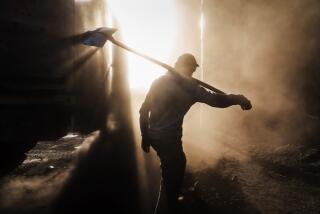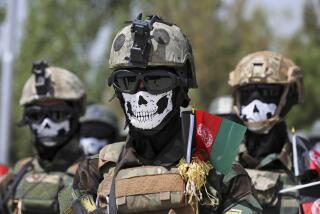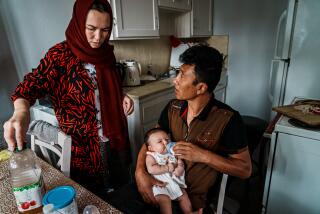7 U.S. Troops Are Killed in Assault on Enemy Fighters
- Share via
WASHINGTON — Enemy fire killed seven helicopter-borne soldiers on a reconnaissance mission, Pentagon officials said Monday, as the largest offensive of the Afghan war turned increasingly deadly for American troops.
A soldier fell to his death when a Chinook helicopter was hit by a rocket-propelled grenade and crashed, said Navy Cmdr. Frank Merriman, a spokesman for the U.S. Central Command. Six other soldiers ferried in by a second helicopter to infiltrate the area were killed in ground combat, he said, but their chopper managed to rescue the downed crew.
For the record:
12:00 a.m. March 6, 2002 FOR THE RECORD
Los Angeles Times Wednesday March 6, 2002 Home Edition Main News Part A Page 2 A2 Desk 1 inches; 27 words Type of Material: Correction
Canadian reporter--A story in Section A on Tuesday said that Kathleen Kenna, a journalist who was injured in Afghanistan, was employed by the Toronto Globe & Mail. She works for the Toronto Star.
A third helicopter was reported to have been downed by a rocket-propelled grenade, but Merriman said there were no reports of deaths or injuries in that incident.
The deaths bring to eight the number of U.S. soldiers killed so far in the three-day assault on the mountains near Gardez in eastern Afghanistan.
At least 40 Americans have been injured since the air and ground attack began early Saturday, Army Gen. Tommy Franks, head of the U.S. Central Command, said in a separate news briefing from Tampa, Fla. Few suffered life-threatening injuries, and nearly half have returned to duty, he said.
Afghan fighters allied with the U.S. in the area said Taliban and Al Qaeda forces were suffering heavy casualties under relentless U.S. bombing. U.S. forces have killed 100 to 200 in the battle, Franks said.
“Even now as I am speaking, I hear helicopters landing as well as bombers overhead,” Safi Ullah, a member of the shura, or council, in Gardez, said by telephone. “The Americans are trying to beat them up before they start the ground attack. And they have also blocked three escape routes from the mountains.”
Pentagon officials have described the area as the last major center of Al Qaeda resistance but say smaller cells remain elsewhere.
“This will not be the last such operation in Afghanistan,” Defense Secretary Donald H. Rumsfeld said. “Not all Taliban and Al Qaeda forces have been defeated. Substantial pockets of resistance remain. They’re determined. They’re dangerous. They will not give up without a fight. They are hiding in the villages and in the mountains and just across the borders, in a number of directions from Afghanistan, and they’re waiting for their opportunities.”
U.S. helicopters are “straining their capabilities,” said Gen. Richard B. Myers, chairman of the Joint Chiefs of Staff. Flying at altitudes up to 12,000 feet in 15- to 20-degree temperatures can limit a helicopter’s ability to climb out of trouble, he said.
Further complicating matters for the helicopters is the geography of the battlefield. The jagged mountain ranges of southeastern Afghanistan rise close together, creating narrow valleys from which it would be relatively easy to fire at a large, slow-moving helicopter such as the Chinook.
“The altitude and temperature have a tremendous effect,” said Charles Bailey, a commercial pilot in Oregon who flew Chinook helicopters in Vietnam in 1970 and ’71. “If you lose one engine at that altitude and temperature, you’re going to go down.”
Known for its brute strength and reliability, the twin-engine Chinook has been the workhorse of the military helicopter fleet since the 1960s. The helicopter is commonly used for moving troops and heavy pieces of artillery--but typically only into areas that have already been secured.
Chinooks can be crippled if hit in any one of several vulnerable points. Miles of critical hydraulic lines snake through the cabin, and a drive shaft that connects the front and back rotors is all that keeps their blades from slapping against one another. Even under optimal conditions, the craft are so large that “a blind man could hit them,” Bailey said.
Monday’s death toll equaled the previous deadliest incident for Americans, which occurred Jan. 9 when a tanker plane crashed into the mountains of Pakistan, killing seven Marines. The first American soldier slain in the current offensive, Army Chief Warrant Officer Stanley L. Harriman, 34, of Wade, N.C., was killed by enemy fire Saturday. The Pentagon provided no identifications of the most recent fatalities, although Rumsfeld said their bodies have been removed from the battle area.
“We sent teams in, and there’s some serious combat as I speak, and lives are lost, and we send our prayers and tears to those whose families have lost life,” President Bush told high school students and teachers in Eden Prairie, Minn. “But I want to assure the students who are here and the loved ones of those military [service members], defending freedom is a noble cause and it is a just cause, and so long as I am the president of the United States, I will pursue those who want to hurt America and who want to take away our freedoms.”
District Regarded as Al Qaeda Haven
Afghan intelligence officials say they regard the Shahi Kot district, where the fighting is taking place, as the most important remaining haven for Osama bin Laden’s Al Qaeda fighters.
Several large pockets of heavily armed Al Qaeda fighters apparently regrouped there to try to undermine the fledgling Afghan government and attack American troops, Rumsfeld said.
“Their goal is to reconstitute, to try to throw out the new interim government of Afghanistan, to kill coalition forces and to try to regain the ability to use Afghanistan as a base for terrorist operations and, as a byproduct, repress the Afghan people. And we intend to prevent them from doing that,” Rumsfeld said.
Franks, who watched the assault unfold on a live video link, said the fighters might have been simply returning to a fallback position after being defeated elsewhere, rather than consciously massing there for a new assault.
Arabs, who are believed to make up a large proportion of Al Qaeda, began to gather over the last couple of months in the mountains near the village of Zermal in a neighboring valley, retreating to the mountains when U.S. forces came to explore the area, an Afghan intelligence official said.
The treeless and boulder-strewn terrain is difficult for those unaccustomed to it to tread without being thrown off balance. Some of the mountainsides are shale fields, others are loosely packed earth and rock.
The cave complexes in the area are particularly deep and winding, according to local commanders, affording a good place for hiding and secreting away large stores of supplies. Built during the 1980s, the caves would be well-known to local Afghan fighters who used them when they were fighting to free the country from Soviet occupation.
Although Afghan fighters know the territory best, U.S. troops are at the vanguard of the coalition force fighting in Paktia province.
As Many as 900 U.S. Troops Involved
The campaign in November in the mountains of Tora Bora, to the north of the current offensive, had a small number of U.S. Special Forces troops assisting hundreds of Afghan fighters, with air power forming the brunt of the U.S. assault.
But as many as 900 U.S. troops are on the front line of this battle, including soldiers from the 10th Mountain and the 101st Airborne divisions.
Along with the Americans are as many as 200 special operations soldiers from Australia, Canada, Denmark, France, Germany and Norway, Franks said. French fighter pilots also are involved, he said.
Most of the approximately 1,500 Afghan fighters involved are doing less central tasks than the Americans, Franks said.
The Al Qaeda fighters, numbering in the hundreds, are well armed with machine guns, mortars, rocket-propelled grenades and, apparently, surface-to-air missiles, although the latter have not yet threatened coalition aircraft, Franks said. The fighters appear to have preserved their ability to communicate, with runners and possibly satellite telephones and radios.
Intelligence reports suggest that members of the Islamic Movement of Uzbekistan are among those exchanging fire with the Americans, Myers said. That could result in closer ties between the United States and the former Soviet Central Asian nations of Uzbekistan and Kyrgyzstan, where the U.S. has established key bases.
French Mirage planes are expected to be the first to arrive at a new U.S. base in Kyrgyzstan, although Air Force officials say the base is intended to support the Afghan war and not local anti-terror efforts.
Journalist Wounded in Grenade Attack
In Gardez, a staging ground for the operation miles from the battleground, newspaper correspondent Kathleen Kenna of the Toronto Globe & Mail was seriously wounded by a hand grenade thrown at her car as she was returning to the city. Kamal Wazir, a spokesman for the Gardez council, said an American camp came under fire by two rockets and automatic rifles at 3 a.m. Monday in Khowst, a town close to the Pakistani border. No casualties were reported.
*
Hendren reported from Washington and Daniszewski from Kabul, Afghanistan. Times staff writers Alissa J. Rubin in Islamabad, Pakistan; Julie Cart in Denver; and Greg Miller in Washington contributed to this report.
More to Read
Sign up for Essential California
The most important California stories and recommendations in your inbox every morning.
You may occasionally receive promotional content from the Los Angeles Times.













